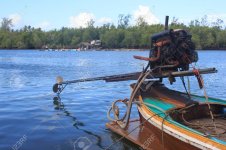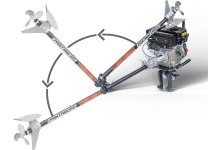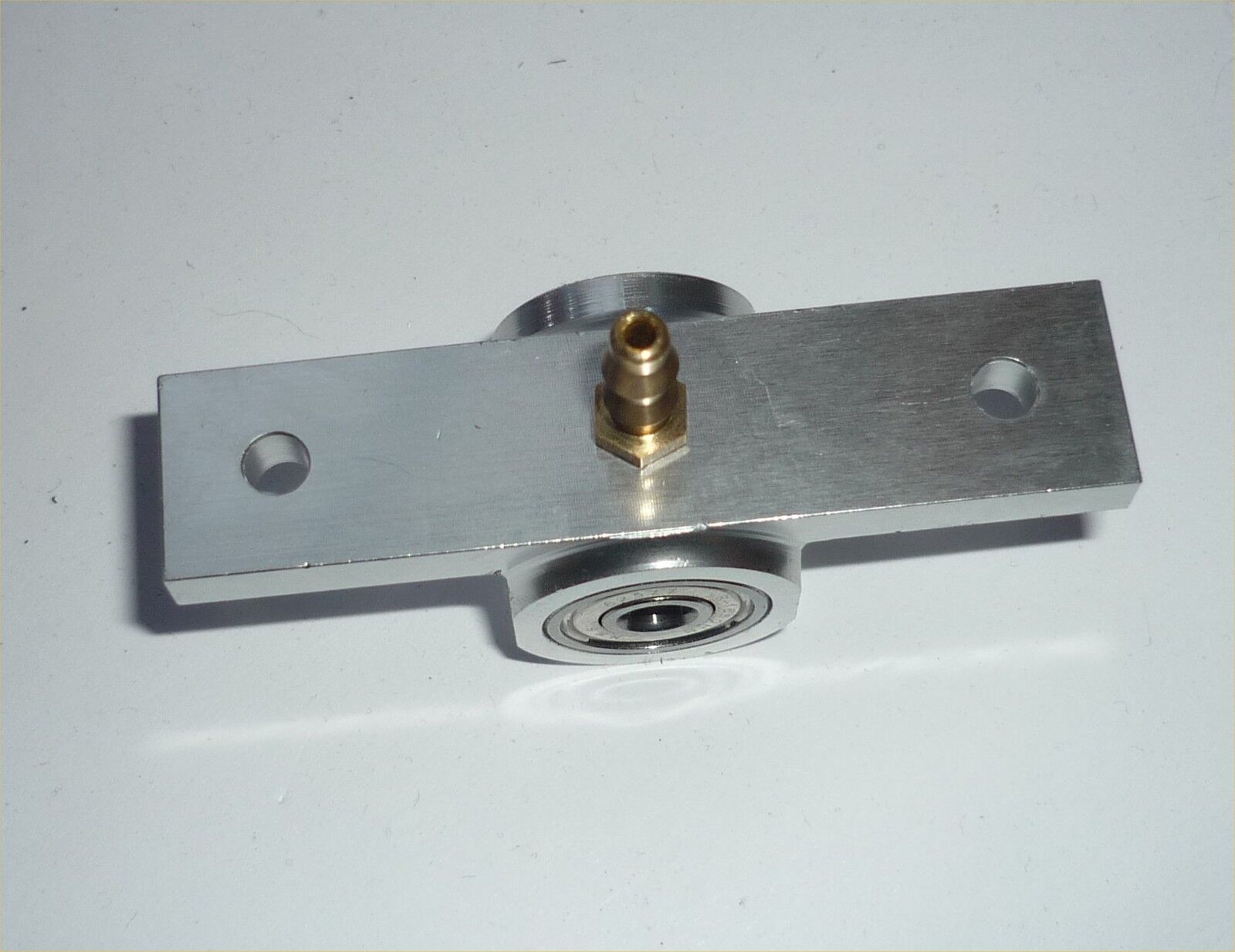You are using an out of date browser. It may not display this or other websites correctly.
You should upgrade or use an alternative browser.
You should upgrade or use an alternative browser.
Getting Into Electric Power Catamarans
- Thread starter bobkart
- Start date
I'd look into a wrecked Zero motorcycle. I'm sure the motor controller, battery, and throttle would work very well for a boat.
If it turned out to be too small, youd likely have no trouble selling it, and if it's too big, it's a good experience. Plus again...once you build the ideal system, you can easily sell the Zero parts...
If it turned out to be too small, youd likely have no trouble selling it, and if it's too big, it's a good experience. Plus again...once you build the ideal system, you can easily sell the Zero parts...
bobkart
10 W
- Joined
- Feb 4, 2021
- Messages
- 92
Good stuff Voltron. I added that approach to my list after seeing the Tech Ingredients video involving those longtail drives:
https://www.youtube.com/watch?v=jYoS8JnCZpw
I still am not sure how the thrust from the propeller is dealt with . . . is there a thrust bearing somewhere along that drivetrain or does the motor itself get subjected to it?
https://www.youtube.com/watch?v=jYoS8JnCZpw
I still am not sure how the thrust from the propeller is dealt with . . . is there a thrust bearing somewhere along that drivetrain or does the motor itself get subjected to it?
bobkart
10 W
- Joined
- Feb 4, 2021
- Messages
- 92
spinningmagnets said:I'd look into a wrecked Zero motorcycle. I'm sure the motor controller, battery, and throttle would work very well for a boat.
If it turned out to be too small, youd likely have no trouble selling it, and if it's too big, it's a good experience. Plus again...once you build the ideal system, you can easily sell the Zero parts...
Ah, our posts crossed. I'll look into that angle; thanks.
Still, with a direct-drive propeller approach, there's the thrust bearing issue I've raised, that's typically not part of a road vehicle solution.
Voltron
1 MW
Not sure, but I'd wager the commercial folding one has it built into the coupler.
Fyi, I've powered some beach cat type hulls, and they have a really different pitch effect compared to power cat hulls. They're built to pitch more around the middle, compared to closer to the transoms. So with the weight of the motors back there, they tend to either get buried in a following swell, or lift out and ventilate, in a way that isn't noticable at first in flat water. It worked out way better having the motor and prop more up forward where the rear crossbar would be. It let the cat hulls have a lot more natural pitch response and kept the prop underwater all the time. But the closer they are to the middle, the less steering effect they have, so whether you have actual rudders still, or just motor vectoring doing the steering is a consideration.
Also, maybe check out prismatic ratios for slender hulls for fun design info.
Electric trimaran has it's pluses too efficiency wise...
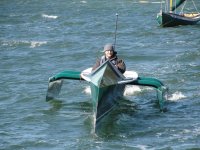
Fyi, I've powered some beach cat type hulls, and they have a really different pitch effect compared to power cat hulls. They're built to pitch more around the middle, compared to closer to the transoms. So with the weight of the motors back there, they tend to either get buried in a following swell, or lift out and ventilate, in a way that isn't noticable at first in flat water. It worked out way better having the motor and prop more up forward where the rear crossbar would be. It let the cat hulls have a lot more natural pitch response and kept the prop underwater all the time. But the closer they are to the middle, the less steering effect they have, so whether you have actual rudders still, or just motor vectoring doing the steering is a consideration.
Also, maybe check out prismatic ratios for slender hulls for fun design info.
Electric trimaran has it's pluses too efficiency wise...

bobkart
10 W
- Joined
- Feb 4, 2021
- Messages
- 92
Interesting observation about pitch response and prop ventilation. I've considered a 'pod' approach, and that would let me position the drive unit pretty much anywhere under the deck:

Although if the pod is steerable, the middle of the boat would not work well. But 2/3 to 3/4 of the way back could be okay. That approach also lets me tweak the height more so than with a transom that won't let you go lower easily.

Although if the pod is steerable, the middle of the boat would not work well. But 2/3 to 3/4 of the way back could be okay. That approach also lets me tweak the height more so than with a transom that won't let you go lower easily.
bobkart
10 W
- Joined
- Feb 4, 2021
- Messages
- 92
Another post-crossing incident.Voltron said:But the closer they are to the middle, the less steering effect they have, so whether you have actual rudders still, or just motor vectoring doing the steering is a consideration.
Yep, without a separate rudder, the middle propulsion position doesn't work well.
Voltron
1 MW
A plus about rudders still is being able to shut off the power going downwind on a nice windy day and still steer.
Also, with a nice semi balanced modern rudder the steering loads are light compared to always pivoting the motor at power, which you need a lot at low speed of course, but much easier to drive with basic autopilot at cruise speeds with motor straight, and steering with rudders, if that's a consideration.
Also, with a nice semi balanced modern rudder the steering loads are light compared to always pivoting the motor at power, which you need a lot at low speed of course, but much easier to drive with basic autopilot at cruise speeds with motor straight, and steering with rudders, if that's a consideration.
Thrust block,
even if the RPM's are acceptable for direct drive, maybe plan on a belt drive to a shaft on the side, with a thrust block on the end of the separate shaft?....
even if the RPM's are acceptable for direct drive, maybe plan on a belt drive to a shaft on the side, with a thrust block on the end of the separate shaft?....
bobkart
10 W
- Joined
- Feb 4, 2021
- Messages
- 92
Yeah, like this picture I posted on the previous page:spinningmagnets said:Thrust block,
even if the RPM's are acceptable for direct drive, maybe plan on a belt drive to a shaft on the side, with a thrust block on the end of the separate shaft?....
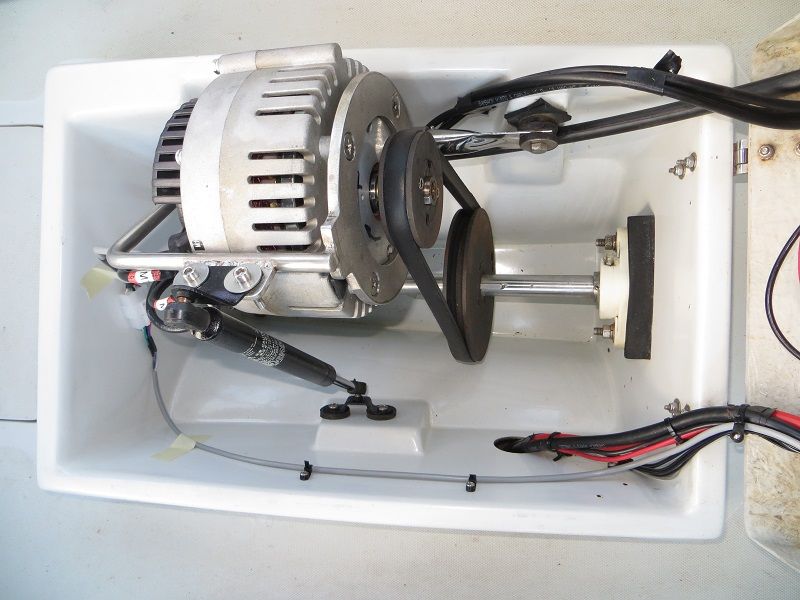
That seems okay . . . but a question about reverse thrust remain . . . that thrust block looks to just resist forward thrust.
It's a workable arrangement but I'm seeing if I can avoid the drive belt overhead. Many inboard electric motors have integrated thrust bearings, so 'it's a thing'. As do V-drives and reduction gearboxes. The issue comes up when trying to use a more generic electric motor (Motenergy for example), that I doubt can take the thrust (resulting in premature bearing failure).
I can find just thrust bearings easily enough, but in a housing is called for (like a pillow block; maybe that's what a 'thrust block' is). And I'm not quite understanding, when the prop shaft is passed through the bearing, how the thrust is transferred from the prop shaft to the bearing. Maybe with locking collars? I raced karts for a while and we used locking collars on the rear axle, snug against the axle bearings. So those bearings acted as thrust bearings (for cornering loads), in addition to taking radial loads (weight of vehicle).
Would love to see just one example of standalone thrust block (not for giant ships) that I could pass my prop shaft through on the way from the motor to the propeller (and bracket with locking collars?). Then I'd have the last piece of the puzzle. Not sure why this isn't showing up right away in searches.
Thanks for your help.
Voltron
1 MW
I'm no expert, but usually I've heard pillow block associated with just mid shaft support and alignment, but not countering thrust load. Also saw thrust box mentioned as an alternative search.
I just did a quick search, and saw a few that combined the two, but nothing good yet.
I just did a quick search, and saw a few that combined the two, but nothing good yet.
Voltron
1 MW
Most of them don't seem water sealing...
bobkart
10 W
- Joined
- Feb 4, 2021
- Messages
- 92
Okay I think my problem is its simpler than I'm thinking it needs to be. I'm seeing that some pillow blocks can handle axial loads:
https://www.mcmaster.com/pillow-blocks/for-load-direction~combined-radial-and-thrust/
So if I match my prop shaft diameter and anticipated thrust (and RPM) against those specs, I think the result of that narrowing will be the answer. Of course I prefer permanently sealed over needing to maintain the lubrication.
Then bracket the bearing inner race with locking collars on the prop shaft, one on each side of the bearing (tight against it). If the locking collar touches at other than the inner bearing race (or is too close for comfort), a small spacer could be added. I think there's probably also a set screw on the inner bearing race, to reduce the chance of the prop shaft spinning inside the inner bearing race.
https://www.mcmaster.com/pillow-blocks/for-load-direction~combined-radial-and-thrust/
So if I match my prop shaft diameter and anticipated thrust (and RPM) against those specs, I think the result of that narrowing will be the answer. Of course I prefer permanently sealed over needing to maintain the lubrication.
Then bracket the bearing inner race with locking collars on the prop shaft, one on each side of the bearing (tight against it). If the locking collar touches at other than the inner bearing race (or is too close for comfort), a small spacer could be added. I think there's probably also a set screw on the inner bearing race, to reduce the chance of the prop shaft spinning inside the inner bearing race.
bobkart
10 W
- Joined
- Feb 4, 2021
- Messages
- 92
Mine can be right after the motor, above the deck. And no stuffing box needed as the deck is open, just a platform above the two hulls:Voltron said:Most of them don't seem water sealing...

bobkart
10 W
- Joined
- Feb 4, 2021
- Messages
- 92
Well those bearings are all fixed alignment and I'm after the self-aligning variety (the karts had those due to axle flex under load).
And they start with an ID larger that I think I need (I want 1" / 25mm or less).
I'll keep looking . . . thanks for everyone's help.
And they start with an ID larger that I think I need (I want 1" / 25mm or less).
I'll keep looking . . . thanks for everyone's help.
Voltron
1 MW
...
bobkart
10 W
- Joined
- Feb 4, 2021
- Messages
- 92
The small cat kit arrived on Wednesday, but I was shorted the four knobs that attached the crossbars to the hulls. They were scheduled to arrive today but weather got in the way, so they won't arrive until Tuesday at the earliest.
I was going to wait until the knobs arrived to take pictures, but gave up on that. Here it is in my rec-room:
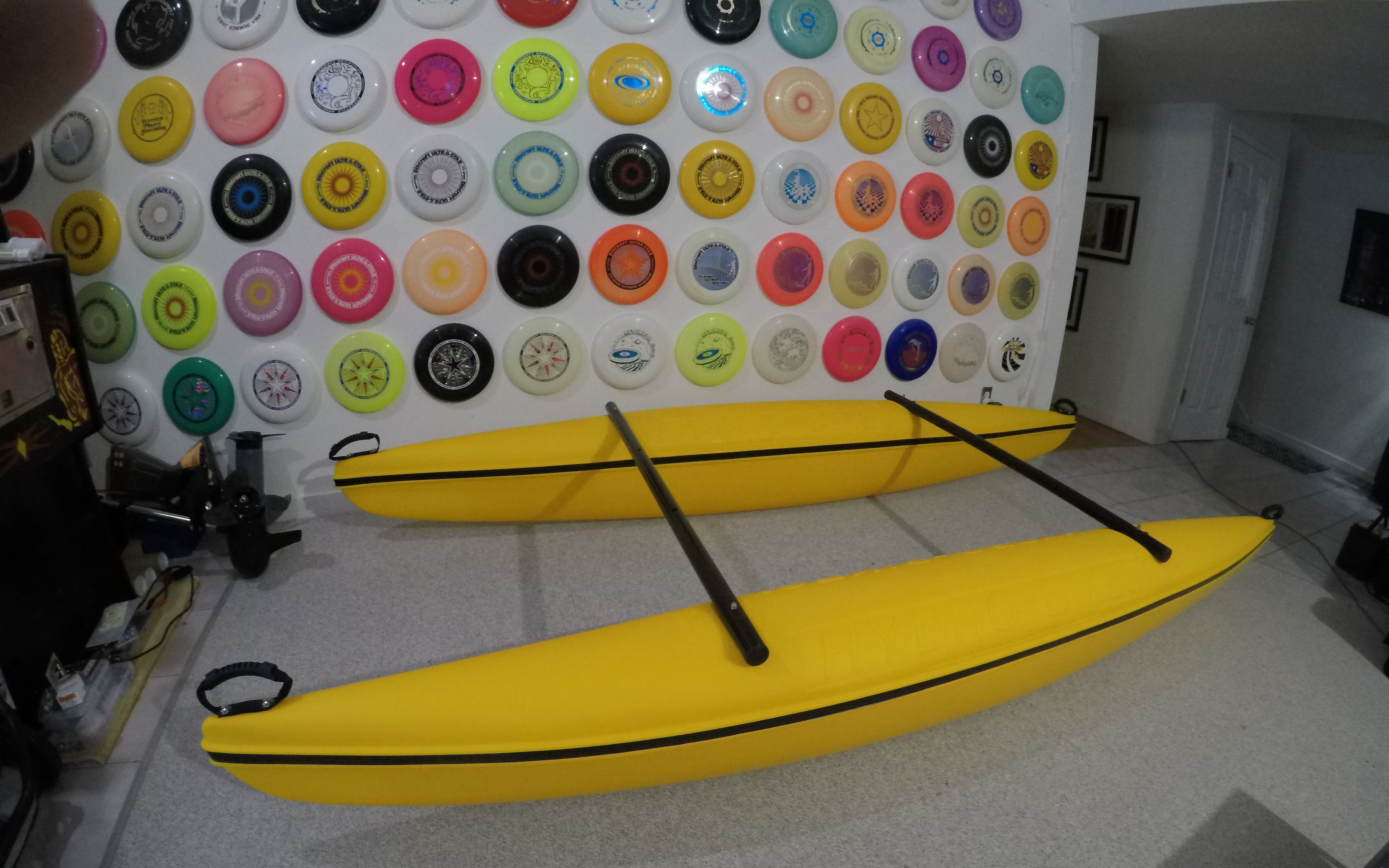
Once the knobs arrive I'll get a baseline weight. By comparing this to the weight of the complete Hydrobike, and the weight capacity they say that has, I can determine how much more capacity I have to work with starting from just the kit. Right now it's looking like 45 more pounds (445 instead of 400). I.e. the complete Hydrobike weights 45 pounds more than this kit.
I was going to wait until the knobs arrived to take pictures, but gave up on that. Here it is in my rec-room:

Once the knobs arrive I'll get a baseline weight. By comparing this to the weight of the complete Hydrobike, and the weight capacity they say that has, I can determine how much more capacity I have to work with starting from just the kit. Right now it's looking like 45 more pounds (445 instead of 400). I.e. the complete Hydrobike weights 45 pounds more than this kit.
SlowCo
1 MW
I'm jealous of your rec-room... 
bobkart
10 W
- Joined
- Feb 4, 2021
- Messages
- 92
Welcome to the thread, SlowCo!SlowCo said:I'm jealous of your rec-room...
One thing I'm wondering about is what effect on performance changing the hull spacing will have. Of course lateral stability will change; is that it? I feel like the inner bow wave interference *might* have some performance on overall drag. I.e. when the hulls are closer together, that interference will happen further forward compared to when the hulls are further apart. But I'm not understanding the consequences of that interference, regardless of where it happens. I.e. is it a good thing or a bad thing? If that interference is to be avoided, having it not happen until the sterns are past it could be desirable (so more hull spacing wins). But again, I get lost trying to think through the consequences of that interference. At first blush it feels like the two mirror-image (laterally) waves could cancel each other out (a good thing?). But that seems too good to be true. Instead I sense a doubling, i.e. each peak gets taller and each trough gets lower (where they meet). Or possibly some kind of reflection happens? I'm just too much of a hydrodynamics noob to think this through.
This may be worth experimenting with. Assuming I can find relatively constant water conditions and use repeatable power levels, adjusting the hull spacing from one run to the next might help answer the question.
Thoughts welcome.
bobkart
10 W
- Joined
- Feb 4, 2021
- Messages
- 92
This strongly suggests that wider hull spacing is better:
"Even a catamaran with a modern wide hull spacing had a drag increase of up to 20 % when compared to hulls at infinite spacing."
From this article (near the bottom): https://www.catamaransite.com/reference/catamaran_hull_dimensioning/
"Even a catamaran with a modern wide hull spacing had a drag increase of up to 20 % when compared to hulls at infinite spacing."
From this article (near the bottom): https://www.catamaransite.com/reference/catamaran_hull_dimensioning/
bobkart
10 W
- Joined
- Feb 4, 2021
- Messages
- 92
DECK MATERIAL next.
At least during prototyping, I've settled on Western Red Cedar fence slats. It's fairly light compared to other wood species, fairly moisture/rot resistant, locally and sustainably sourced, and inexpensive. It will allow easy experimentation with different deck lengths and widths, and configurations of various additions like the transom, seat, battery box, controls.
Once I settle on specific deck dimensions, I suspect there are better options from a weight/performance/durability standpoint (but probably not cost).
Another consideration is that I want the deck to be modular, to accommodate different hull configurations. I.e. a three-hull version would work for a two-person boat, and four hulls might be called for to allow more battery weight, for better range/speed. Decks might range from 3 feet wide to 6 feet wide, and I don't want to build a different deck for each width, instead using standard-width deck pieces to make up the width I'm after at the moment. That approach also helps with portability, as the deck sections can likely go in the back of the car, with only the hulls needing to be put on the roof rack. The idea is to assemble it at the launch point, no trailer needed, or even a boat ramp. This opens up access to many more launch locations than if a trailer and ramp are needed.
So far I have this as my list of decking options:
- wood / plywood
- plastic / fiberglass / composite
- aluminum plate / honeycomb
- carbon fiber
Of course that last one is likely way out of line cost-wise.
Composites look to have the most promise so far, although plain old aluminum diamond plate looks reasonable too. Recently I found some products from Coosa Composites that may work well. They're stronger and lighter than the same size plywood, and not too unreasonable cost-wise. So I may branch out in that direction once prototyping is well underway.
Would love to hear from others as to what deck material they've had experience/success with, or just feel like it's a good option for me to consider.
At least during prototyping, I've settled on Western Red Cedar fence slats. It's fairly light compared to other wood species, fairly moisture/rot resistant, locally and sustainably sourced, and inexpensive. It will allow easy experimentation with different deck lengths and widths, and configurations of various additions like the transom, seat, battery box, controls.
Once I settle on specific deck dimensions, I suspect there are better options from a weight/performance/durability standpoint (but probably not cost).
Another consideration is that I want the deck to be modular, to accommodate different hull configurations. I.e. a three-hull version would work for a two-person boat, and four hulls might be called for to allow more battery weight, for better range/speed. Decks might range from 3 feet wide to 6 feet wide, and I don't want to build a different deck for each width, instead using standard-width deck pieces to make up the width I'm after at the moment. That approach also helps with portability, as the deck sections can likely go in the back of the car, with only the hulls needing to be put on the roof rack. The idea is to assemble it at the launch point, no trailer needed, or even a boat ramp. This opens up access to many more launch locations than if a trailer and ramp are needed.
So far I have this as my list of decking options:
- wood / plywood
- plastic / fiberglass / composite
- aluminum plate / honeycomb
- carbon fiber
Of course that last one is likely way out of line cost-wise.
Composites look to have the most promise so far, although plain old aluminum diamond plate looks reasonable too. Recently I found some products from Coosa Composites that may work well. They're stronger and lighter than the same size plywood, and not too unreasonable cost-wise. So I may branch out in that direction once prototyping is well underway.
Would love to hear from others as to what deck material they've had experience/success with, or just feel like it's a good option for me to consider.
bobkart
10 W
- Joined
- Feb 4, 2021
- Messages
- 92
The knobs finally arrived today (weather delay), and I was able to get a baseline weight reading of between 80 and 81 pounds (just with a bathroom scale). So that 445-pound number I guessed at earlier is holding as the remaining capacity I have to work with.
bobkart
10 W
- Joined
- Feb 4, 2021
- Messages
- 92
I got a better scale and see a baseline weight of 35.23 kilograms or about 77.7 pounds.
Picked up some Western Red Cedar and am playing with deck configurations.
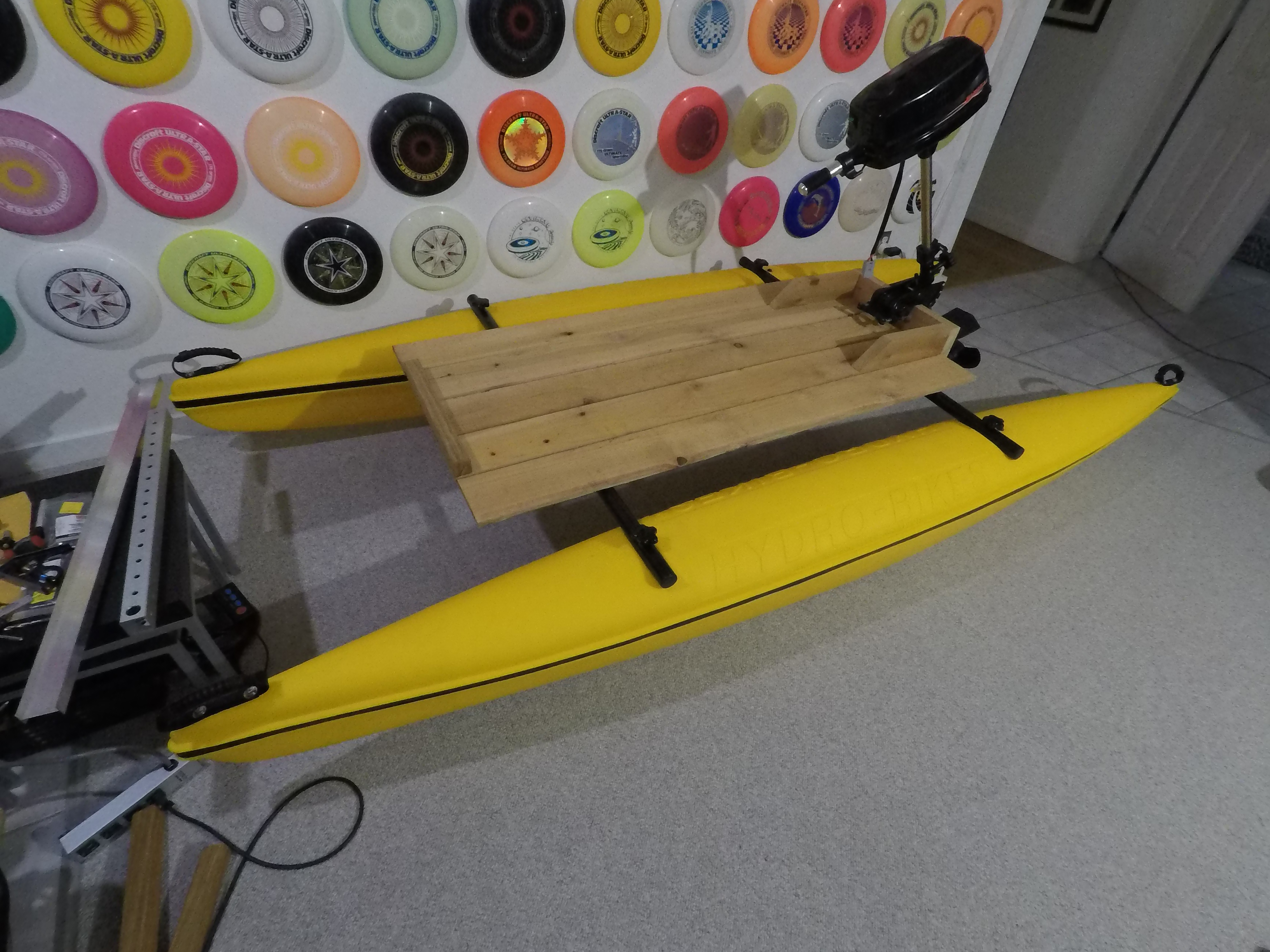
This is close to what I'll likely start with, but I need to make the transom wider, as I'm getting more flex than I want there.
Picked up some Western Red Cedar and am playing with deck configurations.

This is close to what I'll likely start with, but I need to make the transom wider, as I'm getting more flex than I want there.
Similar threads
- Replies
- 43
- Views
- 2,039
- Replies
- 8
- Views
- 2,553
- Replies
- 36
- Views
- 6,731


